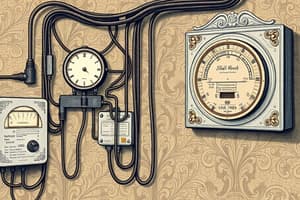Podcast
Questions and Answers
What is the unit of electric power?
What is the unit of electric power?
- Ampere
- Joule
- Watt (correct)
- Volt
Which formula is used to calculate electric energy?
Which formula is used to calculate electric energy?
- R = V / I
- V = W / Q
- P = ΔW / Δt
- ΔW = V × I × t (correct)
What is the type of circuit where components are connected between the same two points?
What is the type of circuit where components are connected between the same two points?
- Series-parallel circuit
- Resistive circuit
- Series circuit
- Parallel circuit (correct)
What is the unit of electric potential difference?
What is the unit of electric potential difference?
What is the formula to calculate resistance?
What is the formula to calculate resistance?
What is the relationship between current and voltage in a circuit?
What is the relationship between current and voltage in a circuit?
What is the unit of electric current?
What is the unit of electric current?
What is the formula to calculate electric current?
What is the formula to calculate electric current?
What is the formula to calculate resistivity?
What is the formula to calculate resistivity?
Flashcards are hidden until you start studying
Study Notes
Electric Power And Energy
- Electric power (P) is the rate at which electric energy is transferred or converted
- Unit: watt (W)
- Formula: P = ΔW / Δt
- Electric energy (ΔW) is the total energy transferred or converted
- Unit: joule (J)
- Formula: ΔW = V × I × t
Electric Potential
- Electric potential (V) is the potential difference between two points in a circuit
- Unit: volt (V)
- Also known as voltage or electromotive force (EMF)
- Formula: V = W / Q
- Electric potential difference is the work done per unit charge in moving a charge between two points
Electric Circuits
- A circuit consists of a closed path through which electric current flows
- Components: source of EMF, conductors, resistors, and loads
- Types of circuits:
- Series circuit: components connected one after the other
- Parallel circuit: components connected between the same two points
- Series-parallel circuit: combination of series and parallel connections
Resistance And Ohm's Law
- Resistance (R) is the opposition to the flow of electric current
- Unit: ohm (Ω)
- Formula: R = V / I
- Ohm's Law: V = I × R
- Resistivity (ρ) is the resistance of a material per unit length and unit cross-sectional area
- Formula: ρ = R × A / L
Current And Voltage
- Electric current (I) is the flow of electric charge
- Unit: ampere (A)
- Formula: I = ΔQ / Δt
- Voltage (V) is the potential difference between two points in a circuit
- Unit: volt (V)
- Relationship between current and voltage: V = I × R
Electric Power And Energy
- Electric power is the rate of electric energy transfer or conversion, measured in watts (W).
- Electric power formula: P = ΔW / Δt, where P is power, ΔW is energy, and Δt is time.
- Electric energy is the total energy transferred or converted, measured in joules (J).
- Electric energy formula: ΔW = V × I × t, where V is voltage, I is current, and t is time.
Electric Potential
- Electric potential, also known as voltage or electromotive force (EMF), is the potential difference between two points in a circuit, measured in volts (V).
- Electric potential formula: V = W / Q, where V is voltage, W is work, and Q is charge.
- Electric potential difference is the work done per unit charge in moving a charge between two points.
Electric Circuits
- A circuit consists of a closed path through which electric current flows, comprising a source of EMF, conductors, resistors, and loads.
- Series circuit: components connected one after the other, with the same current flowing through each component.
- Parallel circuit: components connected between the same two points, with each component having the same voltage.
- Series-parallel circuit: a combination of series and parallel connections.
Resistance And Ohm's Law
- Resistance is the opposition to the flow of electric current, measured in ohms (Ω).
- Resistance formula: R = V / I, where R is resistance, V is voltage, and I is current.
- Ohm's Law: V = I × R, which relates voltage, current, and resistance.
- Resistivity is the resistance of a material per unit length and unit cross-sectional area, measured in ohm-meters (Ωm).
- Resistivity formula: ρ = R × A / L, where ρ is resistivity, R is resistance, A is cross-sectional area, and L is length.
Current And Voltage
- Electric current is the flow of electric charge, measured in amperes (A).
- Electric current formula: I = ΔQ / Δt, where I is current, ΔQ is charge, and Δt is time.
- Voltage is the potential difference between two points in a circuit, measured in volts (V).
- Voltage and current are related by Ohm's Law: V = I × R.
Studying That Suits You
Use AI to generate personalized quizzes and flashcards to suit your learning preferences.




